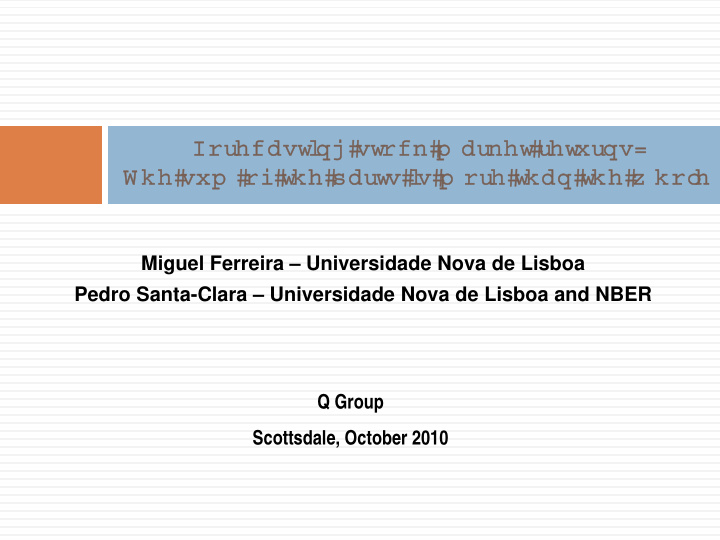



Forecas cast i ng ng st st ock m a m arket re ret urns: T he he sum su of of t t he h par part s i s s m ore m o t han an t t he h w hol hol e Miguel Ferreira – Universidade Nova de Lisboa Pedro Santa-Clara – Universidade Nova de Lisboa and NBER Q Group Scottsdale, October 2010
Forecasting stock market returns 1 � Strong evidence that expected returns vary considerably over time with price multiples, macroeconomic variables, corporate actions, and measures of risk � This variation has important implications for investments and corporate finance applications � Discount rate is opportunity cost from the market � However, the practical gains have remained elusive since there has been no approach to forecast returns that works robustly out of l
Predictive regressions 2 � Regression of returns on lagged predictors with data up to time s Forecast return at time s+ 1 with estimated coefficients and predictive variable at time s � Roll forward until the end of the sample using a sequence of expanding windows
Measuring out-of-sample performance 3 � Evaluate performance with out-of-sample R 2 relative to historical mean
Predictive regressions 4 � Predictive regressions work in sample � Campbell (1987), Fama and French (1988), Hodrick (1992), Cochrane (2008) � Critiques of predictive regressions � Biases due to persistent predictors – Nelson and Kim (1993), Stambaugh (1999), Lewellen (2004) � Data mining – Ferson, Sarkissian, and Simin (2003) � Out-of-sample performance – Goyal and Welch (2008)
Predictive regressions - annual 8
Forecasting is hard... especially the future 9
Decomposing returns 10 � Capital gains � Dividend yield � Total returns � In logs 0.5% 4% 5%
Historic return components 11
Historic return components 12
Sum-of-the-parts approach (SOP) 13 � We forecast each component of returns separately � Expected dividend price estimated by the current dividend-price ratio � Assumes this ratio follows a random walk � Expected earnings growth estimated with a 20- year past moving average � Earnings growth nearly impossible to forecast � Tried analyst consensus forecasts with worse results
Sum-of-the-parts approach (SOP) 14 � 3 alternatives to estimate expected multiple growth � No multiple growth � Multiple growth regression (with shrinkage) � Multiple reversion (with shrinkage)
Sum-of-the-parts approach - annual 16
SOP return forecast (no multiple growth) 17
SOP return forecast vs T-bill rate 18
SOP forecast vs realized returns 19
SOP vs predictive regression vs mean 21
Multiple reversion 22
SOP forecast (all variants) 23
Sharpe ratio gain 26
International evidence 27
International expected returns 28
Monte Carlo simulation 30
Cost of capital for corporate finance 32 � CAPM most used (Graham and Harvey, 2007) � 60% of corporations and 80% of financial advisers use historical market risk premium in the CAPM � 86% of Textbooks/Tradebooks advise to use the historical average market risk premium
The CAPM 33 � Doesn’t work very well out of sample... Out‐of‐sample R‐square (Sample: 1929‐2008) CAPM Growth ‐9.17 Small Value ‐3.21 Growth 0.73 Big Value 0.85
The Fama-French model 34 � Also doesn’t work... Out‐of‐sample R‐square (Sample: 1929‐2008) Fama‐French 3‐Factor Model Growth ‐3.33 Small Value ‐0.46 Growth 0.92 Big Value ‐2.18
The SOP model 35 � Is what you should use! Out‐of‐sample R‐square (Sample: 1929‐2008) Fa ma‐French Fama‐French Sum‐of‐the‐parts 3‐Factor 3‐Factor Model CAPM (SOP) Model CAPM ( SOP estimates ) SO ( P estimates ) Growth ‐3.33 ‐9.17 7.29*** 7.18*** 7.18*** Small Neutral 10.09*** 1.20 ‐1.26 7.38*** 6.81*** Value 6.00** ‐0.46 ‐3.21 5.29** 2.96** Growth 12.62*** 0.92 0.73 10.29*** 13.99*** Big Neutral 13.35*** ‐0.79 0.83 13.79*** 12.05*** Value 11.94*** ‐2.18 0.85 11.19*** 9.61***
Industry portfolios 36 Historical Mean SOP CAPM FF 3‐F actor CAPM FF 3‐F actor Books 8.75*** 4.38** 8.07*** 11.30*** Hshld 5.84** 8.71*** 11.80*** 5.10** BldMt ‐3.08 1.08 9.18*** 5.86 Util ‐4.42 ‐4.50 11.12*** 13.39*** Telcm ‐9.85 ‐12.89 5.69** 3.03** Trans ‐4.51 ‐6.22 8 .16*** 7.42*** Whlst ‐1.04 ‐3.98 10.28*** 9.03*** Rtail 0.60 ‐0.48 6.34*** 7.62*** Meals 2.01* 1.89* 7.03*** 8.61*** Bank s ‐6.60 ‐6.86 2.23* 3.14** Insur ‐6.36 ‐8.37 5.85** 3.41** RlEst ‐0.75 ‐2.79 6.07** 5.24** Fin ‐2.02 ‐1.03 6.19*** 6.36*** Average 40 Industry ‐2.61 ‐1.44 5.71 4.49
Concluding remarks 37 � We show that forecasting components of returns works better than traditional predictive regressions � Instability of coefficients in predictive regressions � Estimation error � We combine a steady-state forecast for earnings growth with the market’s current valuation � Our results revive the long literature on market predictability showing it holds robustly out of sample
Concluding remarks 38 � There are important implications for investments � Tactical asset allocation � And for corporate finance � Time-varying discount rates for project valuation � An open question is whether our results correspond to excessive predictability or time- varying risk premia?
Recommend
More recommend